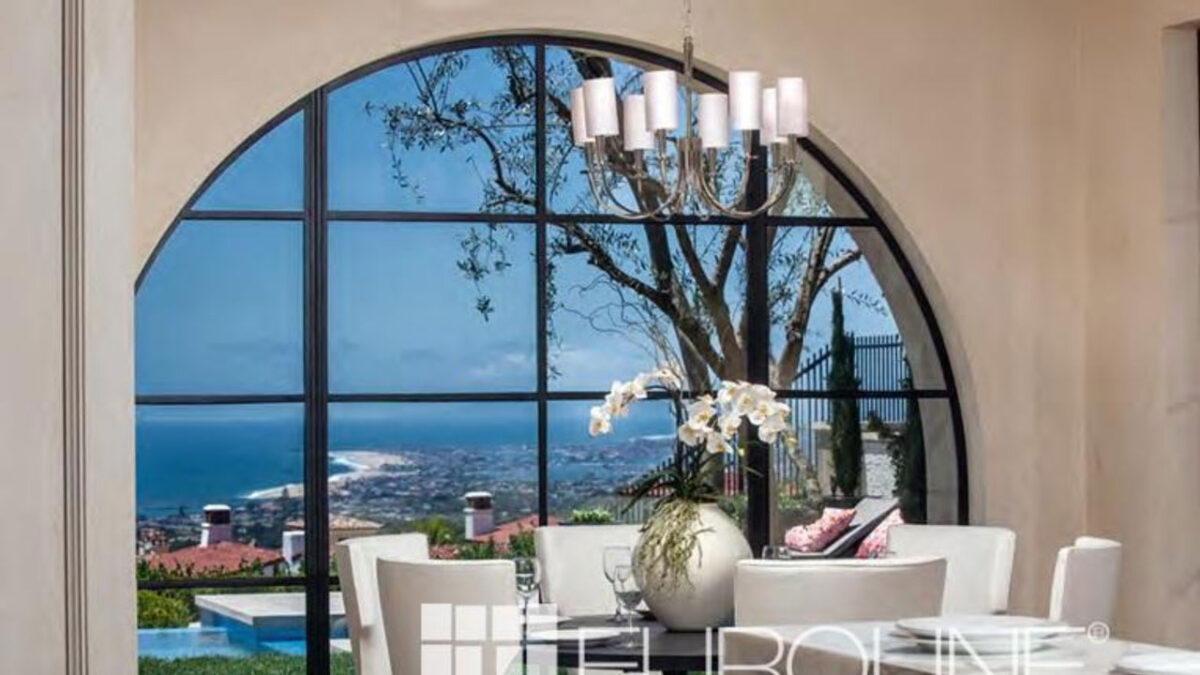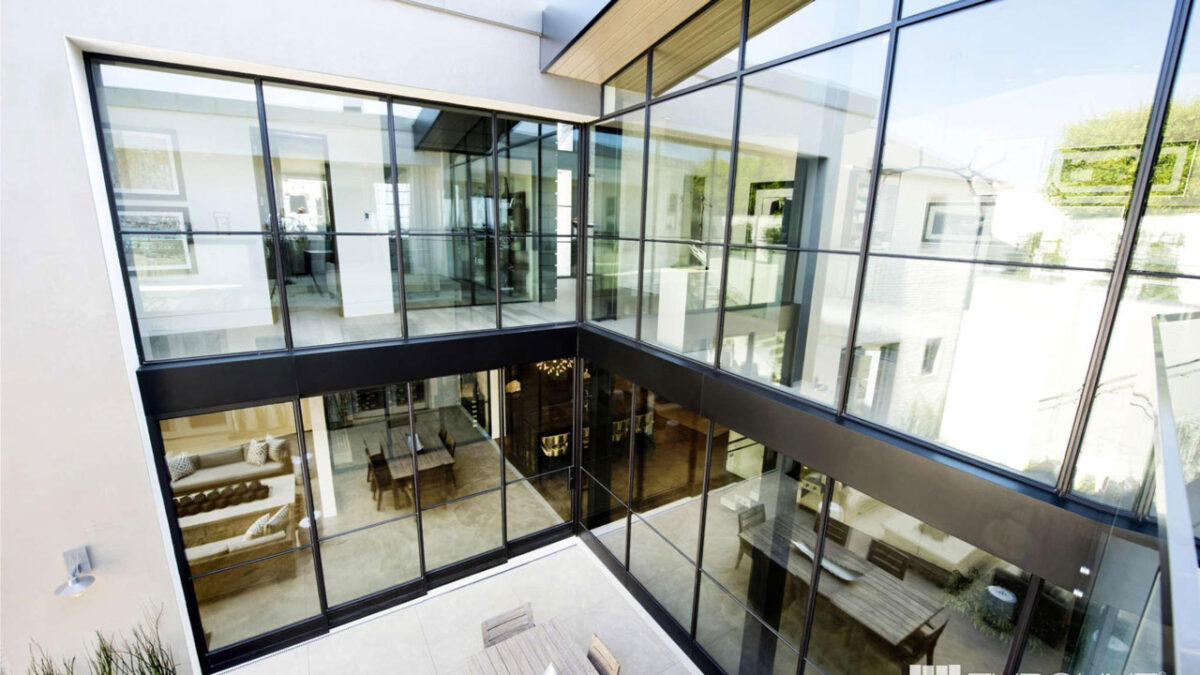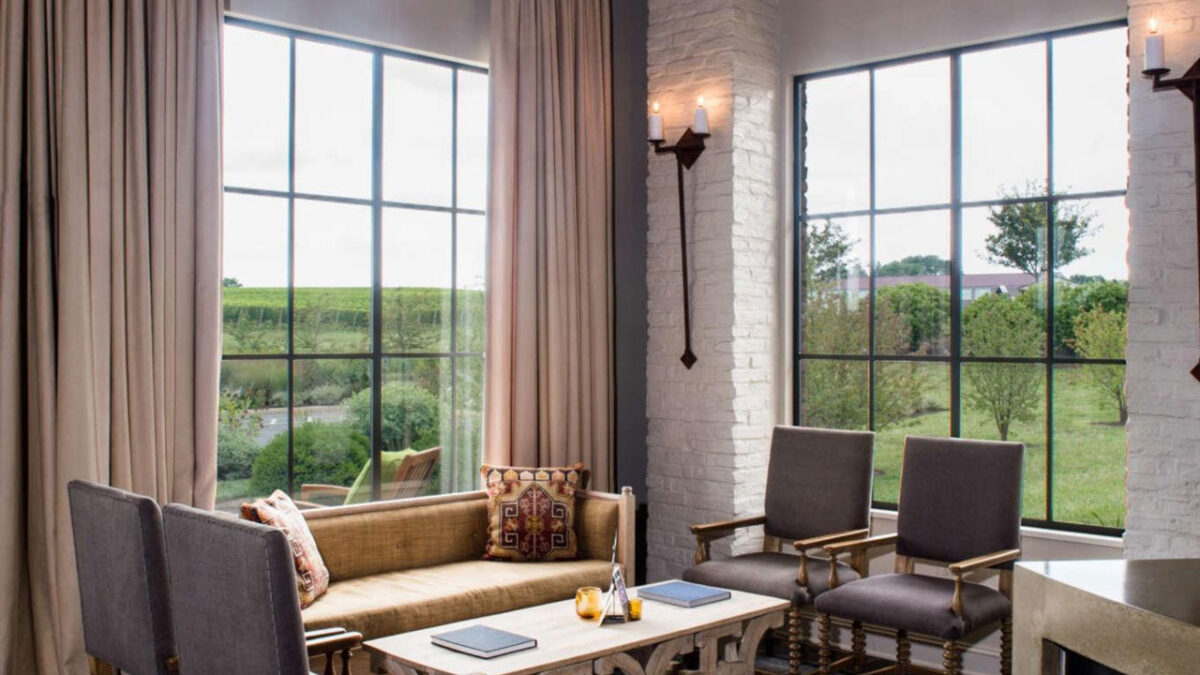Curtain wall systems have redefined modern architecture, blending visual aesthetics with functional excellence. These picture window systems not only serve as the building’s outer covering but also ensure thermal performance, structural integrity, and a seamless influx of natural light. This blog explores various curtain wall window design ideas, incorporating both classic and innovative elements, to inspire your next architectural project.
Curtain Wall Design Concepts
1. Floor to Ceiling Glass
The implementation of floor-to-ceiling glass in curtain wall design is not just an architectural choice; it’s a statement. By eliminating the visual barriers between the interior and exterior, these expansive glass panels invite the landscape or cityscape directly into the building.
This design is particularly impactful in high-rise buildings and commercial spaces, where it can transform the entire building facade into a breathtaking picture wall, offering occupants a unique, panoramic experience. The open, airy feel promoted by this approach significantly enhances the connection between indoor and outdoor environments, fostering a sense of freedom and openness that can boost mood and productivity.
2. Aluminum Frame Integration
Aluminum frames play a crucial role in curtain wall systems, offering both structural strength and aesthetic versatility. The lightweight nature of aluminum allows for various architectural designs, from slim, minimalist profiles that almost disappear from view to more robust, substantial frames that make a bold architectural statement.
This flexibility enables architects to tailor the design to the building’s overall aesthetic, whether aiming for understated elegance or a striking modern edge. Additionally, aluminum’s durability ensures the curtain wall’s longevity, even in harsh environmental conditions.
3. Thermal Insulation and Sound Insulation
Modern curtain wall designs prioritize not just aesthetics but also the comfort and efficiency of the building’s interior. Incorporating advanced thermal insulation within the curtain wall structure is essential for minimizing energy consumption and enhancing the building’s thermal performance.
This is complemented by sound-insulating materials that mitigate external noise, creating a serene, comfortable interior ambiance. Together, these features ensure that the building’s occupants can enjoy natural light and views without sacrificing thermal comfort or acoustic privacy.
4. Luxurious Materials Mix
Integrating luxurious materials such as bronze, stainless steel, or stone cladding with traditional glass panels can significantly elevate a building’s facade. This mix of materials adds texture, depth, and character, distinguishing the structure from conventional designs and imbuing it with a sense of luxury and sophistication.
These materials can be used to highlight architectural features, create contrasts, or harmonize with the surrounding environment, providing endless possibilities for customization and expression.
5. Color Dynamics with Glass Panels
Colored glass panels or tinted glazing can introduce dynamic color schemes into curtain wall designs, transforming the building’s appearance and influencing its mood and atmosphere. From the warmth of subtle beige walls to the cool serenity of blue or green walls, colored glass can create striking visual effects that captivate onlookers and enhance the building’s identity. This approach allows architects to play with light and color, adding another layer of design potential to the curtain wall.
6. Innovative Design Elements
The inclusion of innovative design elements such as geometric patterns, frosted glass sections, or integrated LED lighting can turn a curtain wall into a work of art. These features can serve as focal points, enhance the building’s branding, or simply add visual interest to the exterior. By creatively incorporating these elements, designers can craft unique and captivating aesthetics that stand out while still adhering to the building’s environmental and structural requirements.
7. Historical Fusion
In areas with rich historical backgrounds, curtain walls can be designed to bridge the gap between past and present. By blending 19th-century architectural elements with contemporary curtain wall technology, designers can respect and reflect the historical context while providing the benefits of modern performance and efficiency. This approach can result in a harmonious integration of old and new, celebrating heritage while embracing innovation.
8. Adaptive Window Walls
Adaptive window walls are a response to the need for versatility in changing environmental conditions. These systems can adjust properties such as light transmittance, ventilation, and insulation in response to external factors, ensuring optimal indoor conditions throughout the year. This adaptability is particularly beneficial in regions with significant seasonal variations, contributing to the building’s overall energy efficiency and occupant comfort.
9. Gallery Wall Concept
The gallery wall concept involves utilizing the space adjacent to the curtain wall as a display area for artworks, indoor plants, or other decorative elements. This approach takes advantage of the natural light that floods through the curtain wall, illuminating the displayed items and creating a visually appealing and dynamic interior space. The gallery wall can enhance the building’s aesthetic value, provide a source of inspiration for occupants, and complement the exterior design, creating a cohesive and engaging environment.
Curtain Wall System Challenges and Solutions
Curtain wall systems enhance buildings aesthetically and functionally but present challenges like water infiltration, environmental pressures, high construction costs, thermal performance, sound insulation, and structural integrity. Here’s how to tackle these issues:
- Water Infiltration: Combat this by using quality sealants, ensuring proper drainage design, and regular maintenance to prevent leaks and damage.
- Environmental Factors: Design curtain walls to withstand local weather conditions by conducting environmental analyses and choosing materials like reinforced aluminum frames that resist wind loads and thermal expansion.
- Construction Costs: Focus on value engineering to balance cost, performance, and appearance. Opt for materials and designs that offer long-term savings and durability instead of upfront cost reductions.
- Thermal Performance: Improve energy efficiency with high-performance glass, thermal breaks in frames, and considering building orientation to enhance natural climate control.
- Sound Insulation: Use laminated or double-glazed units to reduce external noise, ensuring a comfortable indoor environment.
- Structural Integrity: Collaborate with structural engineers to ensure proper load distribution and support, maintaining the building’s structural integrity.
Addressing these challenges ensures that curtain wall systems meet performance expectations and contribute positively to the building’s lifecycle. Regular checks and maintenance are crucial for long-term functionality and efficiency.
Elevate Your Space with Euroline Steel Windows
Discover the perfect blend of beauty, efficiency, and durability with Euroline Steel Windows. Enhance your curtain wall design with our sophisticated steel window solutions, tailored to meet your architectural needs. Reach out to Euroline Steel Windows today and bring your design vision to life!




